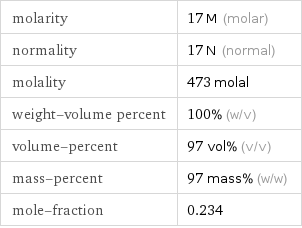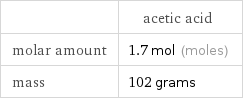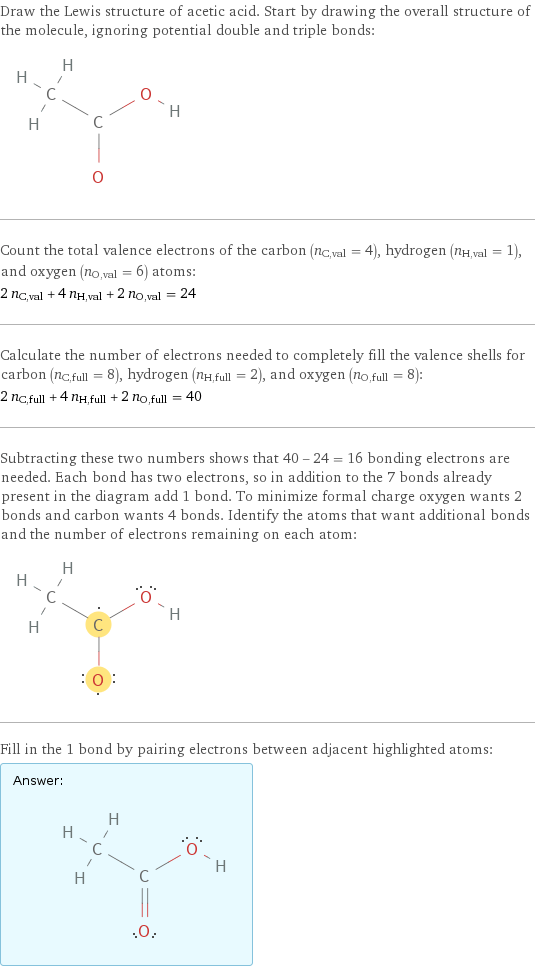Input interpretation

concentrated (17 M) acetic acid
Physical properties

density | 1.057 g/cm^3 (grams per cubic centimeter) surface tension | 28.12 mN/m (millinewtons per meter) dynamic viscosity | 1.727 mPa s (millipascal seconds) refractive index | 1.374 vapor pressure | 2.147 kPa (kilopascals)
Solution properties

molarity | 17 M (molar) normality | 17 N (normal) molality | 473 molal weight-volume percent | 100% (w/v) volume-percent | 97 vol% (v/v) mass-percent | 97 mass% (w/w) mole-fraction | 0.234
Solute properties per 100 mL

| acetic acid molar amount | 1.7 mol (moles) mass | 102 grams
Acid-base information
![K_a | 0.0000175 pK_a | 4.76 pH | 1.76 [H_3O^+] | 0.0173 mol/L (moles per liter) pOH | 12.2 [OH^-] | 5.79×10^-13 mol/L (moles per liter) % ionization | 0.102%](../image_source/8ef02226d6cf9329b1b5e40cb0d28914.png)
K_a | 0.0000175 pK_a | 4.76 pH | 1.76 [H_3O^+] | 0.0173 mol/L (moles per liter) pOH | 12.2 [OH^-] | 5.79×10^-13 mol/L (moles per liter) % ionization | 0.102%
Lewis structure

Draw the Lewis structure of acetic acid. Start by drawing the overall structure of the molecule, ignoring potential double and triple bonds: Count the total valence electrons of the carbon (n_C, val = 4), hydrogen (n_H, val = 1), and oxygen (n_O, val = 6) atoms: 2 n_C, val + 4 n_H, val + 2 n_O, val = 24 Calculate the number of electrons needed to completely fill the valence shells for carbon (n_C, full = 8), hydrogen (n_H, full = 2), and oxygen (n_O, full = 8): 2 n_C, full + 4 n_H, full + 2 n_O, full = 40 Subtracting these two numbers shows that 40 - 24 = 16 bonding electrons are needed. Each bond has two electrons, so in addition to the 7 bonds already present in the diagram add 1 bond. To minimize formal charge oxygen wants 2 bonds and carbon wants 4 bonds. Identify the atoms that want additional bonds and the number of electrons remaining on each atom: Fill in the 1 bond by pairing electrons between adjacent highlighted atoms: Answer: | |
Chemical names and formulas

formula | CH_3CO_2H Hill formula | C_2H_4O_2 name | acetic acid IUPAC name | acetic acid